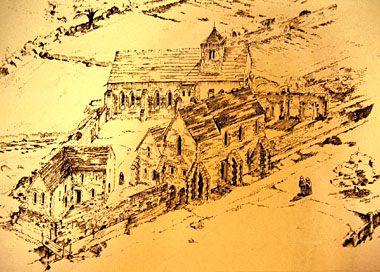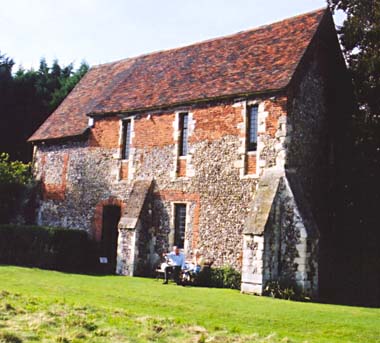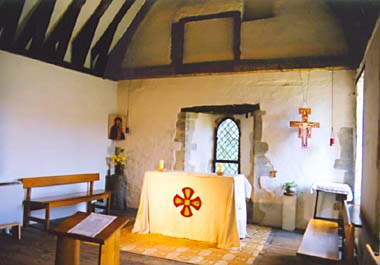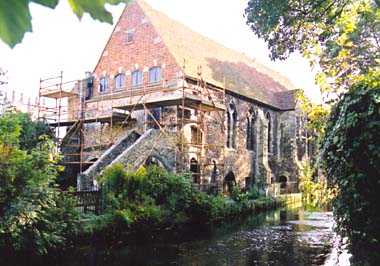
Artist's impression of Canterbury Greyfriars, ca.1500
Photo © S. Alsford
Canterbury was a natural starting point for the orders of friars seeking
to establish themselves in the larger English towns, where they could
best live off charity and best address their task of preaching, as well
as ministering to the poor and the ill (notably at nearby Eastbridge
Hospital). After an inauspicious start to their mission at Dover, where
nearly hanged, five Franciscans arrived in Canterbury in September 1224
(while St. Francis was still alive).
The Master of the Poor Priests
Hospital took them under his wing, giving part of the hospital gardens
to construct their initial buildings. Although this property was
on the periphery of the built-up area of town, it was within the walls
and had immediate access to a water-source, being on a small island within
the River Stour. In 1267 one of the city aldermen, John Digge, gave land
on the far side of the Stour, and there the friars built a preaching church
(the rear building in the artist's impression). By 1498 the friary
consumed 18 acres of land, including gardens and orchards, and there were
35 friars.

Remains of the friary
Photo © S. Alsford
This restored two-storey building of stone, flint and brick is all that remains standing of the Greyfriars complex. It is the central structure in the artist's impression above. Its original purpose is unknown; perhaps a hospitium, infirmary, or the residence of the warden of the community. It sits astride a branch of the Stour, on two pairs of arches.

Modern chapel in the friary building
Photo © S. Alsford
Restoration of the house in the twentieth century made it usable again. A modern Franciscan community established in the vicinity converted the upper room into a chapel, which gives a sense of the same simplicity that must have characterized medieval counterparts. An exhibition on Franciscan history is mounted in another part of the building.

Dominican refectory, Canterbury
Photo © S. Alsford
Further north along the Stour stood an even more impressive friary complex: that of the Dominicans, or Blackfriars. They had first visited Canterbury three years before the Franciscans, but did not establish a house there until 1236. Their wall-enclosed site encompassed 5 acres. All that remains today is the flint refectory (build 1260) and the hospitium for guests. The former is shown above; the projection out of its river-facing wall, at the extreme right of the visible portion of the building, was where a pulpit was located, from which one of the friars would read scriptural passages at mealtimes. After the Dissolution, those structures not demolished were used by weavers as a cloth factory.